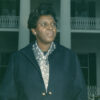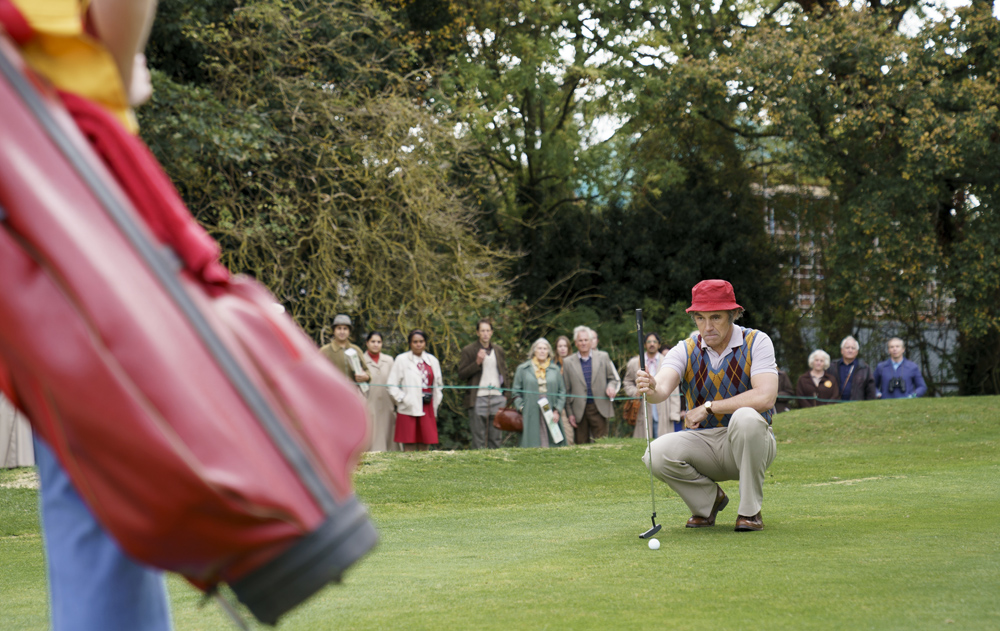It was generally unknown at the time in 1976 that there were few prerequisites to play in the British Open besides filling out the proper paperwork, though there was a question of why anyone who wasn’t the very best of the best at golfing would want to try. While the tournament itself wasn’t off-limits, the barrier to entry was quite daunting when to practice at a club cost significant money, let alone the pricey equipment to practice with and it didn’t only require the physical strength to drive a golf ball hundreds of yards, but the mental stamina to compete with those who had no such obstacles to the sport.
Maurice Flitcroft hadn’t considered any of this when he was looking for a hobby after his work as a crane operator in the British port town of Barrow-in-Furness dried up, but he was hardly one to be dissuaded from pushing ahead with anything he set his mind to. Golf is one of many pursuits he can be seen trying his hand at in “The Phantom of the Open,” but strangely the one that sticks despite having little success at it, making for a truly wonderful mystery in Craig Roberts’ third feature as a director. Written by fellow multi-hyphenate Simon Farnaby, the “Bunny and the Bull” star-turned “Paddington 2” scribe who adapted his own biography of Flitcroft for the screen, the film sees Mark Rylance letting loose as the indefatigable amateur golfer who is discouraged by nearly the entire world from stepping up to the tee, except for his steadfast wife Jean (Sally Hawkins) and his twin sons Gene and James (Christian and Jonah Lees, respectively), who are busy pursuing a dream of their own as syncopated disco dancers.
With an irresistible stranger-than-fiction story, Roberts and Farnaby occasionally push away reality as Flitcroft does, capturing a dreamer who can get lost in his fantasies of what could be rather than what is as he finishes well behind the professionals on the tour and becomes enemy number one of its officials (led by Rhys Ifans). Still, he leads a full life that only others can lust after when his heart is full with the love of his supportive family and an active imagination, vividly brought to life with Roberts’ visual panache, Farnaby’s wicked wit and a killer ensemble of actors. After the comedy opened last fall’s London Film Festival, “The Phantom of the Open” is making a winner out of one of the golf’s most infamous losers around the world and with its arrival in the U.S., the director and writer spoke about finding the right way forward to turn Flitcroft’s adventurous life into a film and the many directions this could’ve taken.
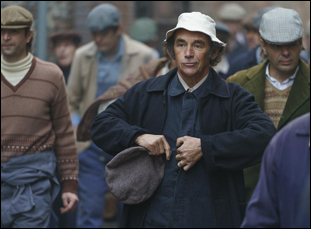
Simon Farnaby: That was a huge thing for me. I actually wrote a screenplay first [before writing the book the script is based on], which was really bad because it was only based on three or four facts about Maurice and I had to make the rest up. [laughs] Then I went to visit his sons Gene and James, who are still alive, and I said to them, “Look, I really need some more stuff. Do you have a diary or some letters or anything of your dad’s and they went, “No, no… Can’t think of anything.” Then one of them went, “What about his autobiography?” [laughs] And they went under their bed and got this 500-page autobiography with Maurice’s handwriting, of course unpublished. They sent it to various publishers who just sent it straight back.
But it was a goldmine as a screenwriter [because] you want to know what he was thinking and what was going through his mind. Also, there’s lots of comedy in there. He was a really funny guy, quite unintentionally sometimes, but that really opened up the whole project. The main thing from the story point of view was he was serious. Initially, he definitely thought he was good enough not only to be in the British Open, but to win it and after that, I think it became about trying to prove the RNA wrong and trying to prove himself to his family and everyone else. That was [what] David Lynch calls the eye of the duck moment, realizing he was serious about winning the British Open despite having no skills whatsoever.
Craig, was there an eye of the duck moment for you?
Craig Roberts: Yes, it was the money! [laughs]
Simon Farnaby: The eye of any duck. [laughs]
Craig Roberts: I loved it. The one real moment that made me want to do it was about ten pages in [with Maurice] coming out of the shipyard, and he opens his overalls like Superman, which is weird, but I loved it so much. One of my favorite movies is “Punch Drunk Love” and in that movie, Paul Thomas Anderson frames Adam Sandler as Clark Kent essentially, and there’s loads of references throughout, so Maurice felt like that in his own way,[with] confidence being his superpower. And I loved the humor and the heart and the characters, so I had to do it.
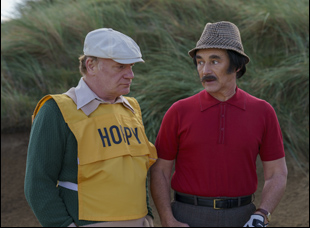
Simon Farnaby: Yeah, I think that might be true.
Craig Roberts: I actually got too obsessed with that, to be honest because [there’s a cut] that was really serious and it was a drama.
Simon Farnaby: And it’s all about the family.
Craig Roberts: Yeah, I got slightly obsessed with the self-sacrifice of [Jean, Maurice’s wife played by Sally Hawkins] doing everything and helping him, which is the wrong movie and not this movie at all. But Sally’s just so good, you want to keep all her scenes in. So I don’t think I added more of it, but I probably leaned into the drama of it a bit more because the script was always very funny, but I thought if we plant our feet in drama, then we can pivot to comedy.
Both the tone and the story is set up so well through the first five minutes, a breathless montage of Maurice’s life before the British Open. What was it like to crack that many scenes where it’s so fun and exposition-filled all at once?
Simon Farnaby: Well, I’m glad you say that because they were trying to get us to cut it at one point. [laughs] The first cut of the film is always a bit long and it’s like, “Can we lose the first 10 minutes?” And I went, “No, because the whole backstory of Maurice is really important to me” and again, another eye of the duck moment, if you can have two…
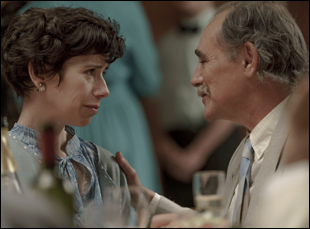
Simon Farnaby: Ducks have two eyes, right? But in the autobiography, Maurice says that he was from a very working class background and all it was was the shipyard. That’s the only option. Then the war came and he was evacuated to Scotland and lived with a very middle class posh family where he read books and learned the violin and different languages. So right in the beginning of the movie where [Maurice] is narrating was so important to me because that opened up his whole character. This is someone who was dealt a hand in life when he was born, the birth lottery, as Craig calls it, which is a great expression, like “You’re going to stay there. You’re going to work in the shipyard,” and when he went to Scotland in this rare evacuation, he was like, “Wow, here’s another life” and he said he was the only kid who didn’t want the war to end. [laughs] Then when it did, he had to go back to Barrow, but he brought that attitude with him, which is more in wealthier households where you can do whatever you want to do, but he went back to a very poor household.
Craig Roberts: Also, there was a lot more to it [originally]. We showed Maurice trying different things because he didn’t just try golf. He tried many, many things…
Simon Farnaby: Yeah, he tried to write songs. He was quite a good painter actually and he was a comedy high diver — actually, he couldn’t do that. He went to an audition and he fell off the diving board and he said, “No, that’s what I do. I’m the guy that falls off things.” [laughs] And they went, “Okay, we’ll have you.” So he tried quite lots of things and then he took a break for 20 years and found golf. There we agreed with some of the producers that “This is a bit too long” [since it] was about 20 minutes before the film started, but it was really important to set up his entire character.
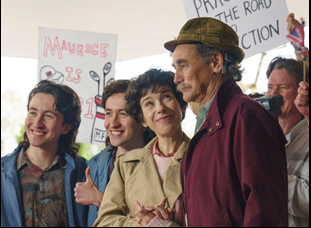
Simon Farnaby: Maurice’s artwork is entirely copied from Vincent Van Gogh. Everything. He actually painted his wife a lot and did self-portraits and Craig ran with that. All the visual things I wanted to do, but wouldn’t have had a clue how to make real on screen, I was really delighted with how that came across. The stars motif [specifically] built into the way that Maurice would reach for the stars and couldn’t quite get there, so that was a very pleasing confluence of the idea and the direction of making it happen.
Craig, there are a lot of wild one-take shots in this film with a lot of camera moves. Was there a particularly hard one to pull off? The first qualifier that Maurice plays in for the British Open looked like a doozy.
Craig Roberts: That was just fun. That wasn’t hard. I’ll tell you the shot that was hardest to pull off and it’s not even in the bloody movie — the moment where [the Flitcrofts’] house went on fire, the gas oven blew up originally in the movie and I’d kept the grammar in the movie that there was no handheld at all. I wanted it to be on tracks and motivated moves, almost like “Taxi Driver,” and it [would] push into Maurice at the right time. So we hadn’t done any handheld and I did a shotlist that at this moment in the movie, we’ll travel with [Maurice] running as he sees his house on fire and then as he’s about to go into the house, we’ll come off the vehicle handheld and then run into the house on fire, so we put the [director of photography] on the back of the car, it traveled around the street as he was running and then the DP jumped off the car, ran in with the fire. And it’s not even in the movie. But that was my hardest shot.
Simon Farnaby: The hardest shot I had to do was hit that golf ball off the tee in my acting role, so… [both laugh] There you go.
“The Phantom of the Open” opens on June 3rd in Los Angeles at the AMC Century City and the Laemmle Royal and New York at the Loews Lincoln Square 13, the Regal Union Sqaure 14 and the Cinemas 1, 2, 3 before expanding wide on June 10th. A full list of theaters and dates is here.



